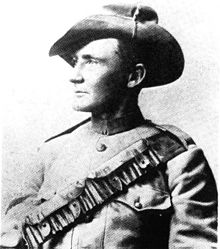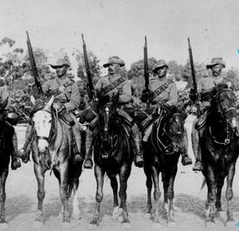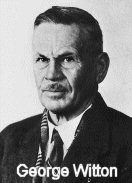
Well, let’s face it. Villain. By his own admission he done it. What did he do? Shot several unarmed prisoners during the Boer War and his defence was he was only following orders and the rule he used was ‘rule 303’ named after the rifle of the same name. However, a century after these events this ‘son of Bridgwater’ is the subject of a campaign for a posthumous pardon (or at least a retrial) by a group of Australian historians and at the same time reviled as a war criminal by a group of South African historians. The British Government continues to steadfastly refuse to reopen the case.
Breaker Morant has been glamourised in numerous accounts of his life, included a blockbuster film in 1980 (Bruce Beresford’s ‘Breaker Morant’ starring Edward Woodward) in much the same way he seems to have lived his own life – ie full of bluff, exaggeration, risk taking, gambling and outright lies.
So what do we know for sure……

We know he was born on December 9th 1864 in the Bridgwater workhouse and his birth certificate records his name as Edwin Henry Murrant.
We know his parents were Edwin (from Honiton) and Catherine Murrant (born O’Reilly, somewhere in Ireland) and that they were Master and Matron of the Workhouse -having moved there in 1861 from Devon.
We know he had an older sister Annie Kate Murrant (born 1863 and who later lived in Hamp and taught music) and that his father died on August 25th 1864 and is buried in Wembdon road cemetery barely 4 months before he was born.
And we know that his mum, Catherine, stayed on as Matron of the workhouse until 1891, even though the replacement master (James Winterson) was a bitter enemy of her, taking each other to court on numerous occasions over their respective behaviour to each other. Catherine was ascribed behaviour that was wild, drunk, noisy, ‘blowing tin whistles’ , ‘throwing towels’ and generally disrespectful – including one odd charge of being ‘drunk on carnival night’ (hardly odd for Bridgwater) . But, this was all part of a demarcation dispute within the workhouse so we can file it under ‘conjecture’. Catherine returned to Devon and died there in 1899 aged 66.
Leaving his past behind

It’s very likely that Morant was ashamed of his workhouse connections which had a reputation for disease, prostitution, failure and abandonment. Similarly his real parents came from “that class more despised than the paupers , those that guarded them”.
Breaker got his name from his subsequent expertise in ‘Horse breaking’ and his subsequent middle name ‘Harbord’ certainly as a ‘nickname’. One of Queen Victoria’s key court favourites and media celebrities was called Horatio Harbord Morant and this was certainly picked up from there. By the time he reached Australia he had assumed it as his middle name and was thereafter officially Harry Harbord Morant.
In the 1871 census he was listed as a scholar at the Bridgwater Union Workhouse aged 6 but by the 1881 census he was recorded at the Silesia College, Chipping Barnet (now North London) as a 17 year old Tutor. Silesia College was a bog standard Victorian boys’ boarding school of which there were many around the country. In 1882 the fees were 25 guineas a year (at a time when £1 a week would be a good wage for an unskilled working man). It is possible that Mrs Murrant scrimped and saved to send her boy to a minor public school or it is possible he worked as a tutor to help pay these fees.
By 1883 he had opted to leave for a new life in Australia aged 19 and embarked at Plymouth on the SS Waroonga and disembarked at Townsville in Queensland.
Creating a new life as ‘the Breaker’

His new life in Australia saw him self identifying as ‘a gentleman’ claiming parentage from a famous British Admiral Sir George Digby Morant (1837-1921) and marrying Daisy May O’Dwyer in 1884 at the age of 21. Daisy saw through him quite quickly and ditched him when he failed to pay for the wedding (he avoided paying the Clergyman his honorarium and wrote a cheque that subsequently bounced) and stole some livestock (32 pigs)– for which he is also noted in court records for that same year as ‘thief’. Daisy, incidentally, was an Irish born journalist who later became a well respected campaigner for Aborigine rights under her later married name of Daisy Bates.
Morant, undaunted, took to his new life in the wild south of Australia and earned a reputation – true or exaggerated – as a horse breaker (a tamer of wild horses) and a bushman. At the same time he developed a career as a published bush poet. Clearly inspired by the company he kept, notably bush balladeer and poet Banjo Paterson (who wrote the swagman’s anthem Waltzing Matilda 1895) he lived a free and easy womanising hard drinking lifestyle, taking time off now and then to send his poems to the local newspaper, thus bigging himself up and enhancing his public image as ‘the Breaker’.
Patersons letters to and from Morant reveal a fascination with each other and see Morant fabricating tales of a life amongst the ‘upper classes of Devon’
Not everyone was taken in however, and Banjo Paterson’s uncle Andrew Barton wrote of Morant “He says he is the son of an English Admiral and has good manners and education and that he can do anything better than most people…..except work! I don’t know what is the matter with this chap. He seems to be brimming over with flashness!”
In 1889 Morants first poems appeared in Australian magazine ‘The Bulletin’ under his pen name ‘The Breaker’
In the 1890s the Breaker worked for the Ogilvie family at their orange orchard and the Cutlack family, who were related to Sir Digby and who appear to have believed Morant when he said that he was a relative -although the Admiral himself persistently and publically denied paternity throughout his life.
On the dark side

Morants self publicising was often balanced by reports of his alleged sadism. On the one hand he could be charming and cultured but on the other hand there are reports of cruelty to Aboriginal people who he would on occasion lure into a stable for a friendly boxing match but then “lock the door to prevent escape and beat the man unconscious” according to Morris Hawkins the son of one of his employers. Another story tells of him beating a dingo to death with a stirrup iron, hamstringing a heifer with a knife and using a lancers spear to hunt pigs admitting to Paterson “pigsticking is not bad fun.”
And so to war
In 1899 the 2nd Boer war broke out in South Africa. The background to the war was rooted in Britain’s Imperialist desires in South Africa, where it controlled the Cape colonies and a string of states stretching from Cape of Good Hope in the south to Cairo in the north . Balanced against this was the desire for independence by the Boer states of Transvaal and Orange Free State -which had been won in the first Boer war of 1881, but now became precarious upon the discovery of gold and diamonds….something the British certainly fancied. Britain called on her Empire to join the fight and 16,000 volunteers from Australia were among those that signed up.
Morant enlisted in the second contingent of the South Australian Mounted Rifles where he was appointed as Lance Corporal and was recorded as Lieutenant Harry Harbord Morant (by now his official name) by the time he’d reached South Africa in February 1900

The war went bad for the British, who fought conventional 19th century set piece battles against Boer guerrilla armies who laid siege to their key cities -Ladysmith, Mafeking etc, all which had to be relieved by large field armies.
As British resources and numbers were poured into the region the war took a darker turn with the Boers employing commando tactics including hit and run attacks and other strategies used thereafter in guerilla wars the world over. The Brits, under new commander Lord Kitchener, employed similar tactics and in typical British imperial fashion to the extreme, fighting fire with fire and setting up units to fight a dirty war with the enemy including setting up the worlds first Concentration camps that rounded up entire populations and impounded them with some 30,000 dying in insanitary conditions.
Enter The Bushveldt Carabineers

One of the most notorious of these counter insurgency units was the BVC-the Bushveldt Carabineers-mounted irregulars who operated well behind enemy lines. Morant signed up for these.
In September 1901 Morant and fellow lieutenant Peter Handcock were arrested and court martialled for war crimes, namely the summary execution of Boer POWs. They were also charged with the murder of German missionary Daniel Heese (who had witnessed the killings) but were acquitted of that one due to insufficient evidence.
The specific case had come about following a period where things were going quite well for the Breaker. At the start of the year he was taking a break in England and had made the acquaintance of a fellow officer Captain Hunt. Together they dated a pair of sisters from Devon it seems. However, by April both Morant and Hunt were back in South Africa and had signed up for the BVC-a 320 strong regiment formed in February 1901 by Australian Colonel Lenehan.

Morant commended one of 2 columns which operated in the Strydpoort district and which targeted and eliminated enemy commandos. The BVC O/C in the region was the extremely dodgy Captain Alfred ‘Killer’ Taylor and the man who appears to have imposed the ‘shoot first ask questions later’ policy which he claimed came by word of mouth from Lord Kitchener. Needless to say Taylor was acquitted of all charges -which gives rise to claims of a stitch up.
On 5 August 1901 the incident which sparked the beginning of the end for Morant took place. His best friend Captain Hunt led a 17 man patrol into a Boer ambush at Devils Gorge and was killed. Hunts body was mutilated but it isn’t clear whether this was by the Boers or subsequently by scavengers. When Morant learnt of the detail he was deeply distressed and reacted badly calling on a relief column to ‘give no quarter’ and to ‘avenge the death of their captain’.
Despite suggestion to the contrary it is likely that Morant in fact didn’t see the body himself

Consequently Morant led a detachment out which attacked and captured Boers and personally gave the order to execute them. A single captive called Visser being the first and another 8 subsequently.
Arrest and trial
On October 24th 1901 he was arrested alongside other BVC officers including Lenehan and Taylor, but just the lieutenants were arraigned for trial -himself, his friend Peter Handcock and a third officer Lt George Witton. Taylor (a British officer) it has been claimed ‘had friends in high places’.
The nature of the trial forms the basis of the Australian campaigners case against the sentences. No charges were provided to the prisoners until 15 January 1902 and an inexperienced Australian solicitor Major James Thomas was assigned to defend them at the hearing which started immediately the following day.

All three were found guilty and sentenced to death with Kitchener signing the death warrant – but then suddenly making himself unavailable to consider any last minute reprieve. Wittons sentence was commuted to imprisonment (at Portland Dorset and just serving 28 months ) while Morant and Handcock were sent to face a firing squad.
Witton went on to further propagate the Morant legend with his book ‘Scapegoats of Empire’
Execution and legacy
In 1902 he is finally listed in Prison records in Pretoria as ‘convicted murderer’ aged 35. He was executed by a detail of the Cameron Highlanders at dawn on 27th February alongside his friend and fellow war criminal lt Handcock.
Morant left a confession written on the back of a photograph
“To the Rev. Canon Fisher Pretoria.The night before we’re shot We shot the Boers who killed and mutilated our friend (the best mate I had on Earth) Harry Harbord Morant Peter Joseph Handcock”

Both died announcing they were ‘pagans’ – Morants idea- as Handcock seemingly didn’t know what it meant, but liked Morants description. Morant was asked if he wanted a clergyman to which he replied ‘No! I’m a pagan!”
Refusing to be blindfolded his last words were reputedly “Shoot straight you bastards, don’t make a mess of it”
Morant also left a ‘last rhyme and testament’ in his prison cell written the night before “whilst waiting cru-ci-fixion” and signed The Breaker.
The court martial proceedings were not made public and official transcripts disappeared soon afterwards.
In 2012 South African historian Charles Leach published research that he claimed showed the BVC crimes were “worse than originally thought” and today Afrikaaner historians such as Andres Pretorius claim “up to 35 victims” of Breaker Morant.

The Australian case for the reprieve of Morant is headed by Lawyer James Unkles who maintains a web site and was behind the 2014 film ‘Breaker Morant the retrial’. Unkles site can be accessed here.
The Australians case is that Morant and Handcock were made ‘scapegoats’ and unfairly singled out for punishment in a conspiracy that goes to the very top – in this case to cover up the illegal orders of lord Kitchener himself. A petition to pardon Morant and Handcock was sent to the Australian Parliament in 2009 and to the Queen in 2010. Neither were successful. The Australian Government position is that “ pardons are only appropriate where an offender is both morally and technically innocent. A pardon for these two men could be rightly perceived as glossing over very grave criminal acts”. Unkles continues to campaign for a judicial enquiry.
Maintaining his story until the end Morant left his cigarette case in the capable hands of one of the prosecuting officers saying “make sure my family gets this” -which came as a great shock to Sir Digby Morant when presented with it and who continued denying any knowledge of the imposter until his dying day.
